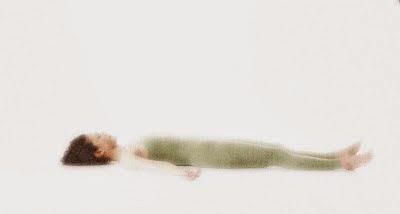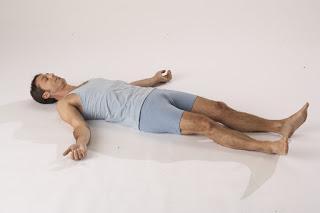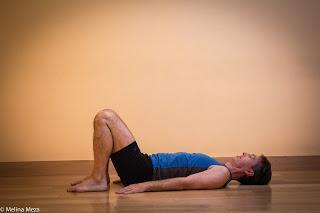 This powerful pose provides deep physical rest, allowing you to completely relax your musculoskeletal system in an anatomically neutral position. And if you practice it with a mental focus—which we hope you will—this pose triggers the relaxation response, reducing your stress levels and allowing you to spend time in the Rest and Digest state. For those who can’t meditate in a seated position (or who prefer not to), you can use this pose for any form of meditation (as long as you don’t fall asleep).
This powerful pose provides deep physical rest, allowing you to completely relax your musculoskeletal system in an anatomically neutral position. And if you practice it with a mental focus—which we hope you will—this pose triggers the relaxation response, reducing your stress levels and allowing you to spend time in the Rest and Digest state. For those who can’t meditate in a seated position (or who prefer not to), you can use this pose for any form of meditation (as long as you don’t fall asleep). Baxter prescribes this pose for:
- Resting at the end of a yoga practice, after other physical activity, or when fatigued
- Stress reduction
- Insomnia
- Meditation
- Minor digestive problems
- Mild low back pain (versions 3 and 4)
Timing: For all practitioners, stay in the pose for 5-10 minutes (to trigger the Relaxation Response, aim for 10 minutes). If it is challenging for you to lie still for that long, start with 3 minutes and work up to longer holds.
Cautions: People with low back pain should try version 4 first, then version 3, and work towards version 1. If you still cannot get comfortable, try version 4 of Legs Up the Wall pose instead. Pregnant women the second and third trimester should do version 2 of Reclined Cobbler’s pose, version 2 or rest on their left side. And if you find that lying on your back causes anxiety, you can try a prone position (lying on your belly), such as Child’s pose.
1. Classic Version
 The classic version with no props is suitable only for people who are completely comfortable in this version and who can keep their heads in a neutral position (chin pointing slightly down toward your chest, not tipping back). All others should try versions 2, 3, or 4.
The classic version with no props is suitable only for people who are completely comfortable in this version and who can keep their heads in a neutral position (chin pointing slightly down toward your chest, not tipping back). All others should try versions 2, 3, or 4. Start by lying on your back with bent knees. Then straighten your legs and position them eight to ten inches apart. Turn your arms out so your palms face up and your hands are six to eight inches from your body. And position your head perfectly between your two shoulders, with your eyes about equal distance from the ceiling. Adjust your body so it is as symmetrical as possible and your weight is even on both sides. Now make a commitment to stay still, and turn your awareness inward. The focus for your mind can be your breath, the gradual relaxation of your body (sometimes called a body scan), or a peaceful image. Rather than simply letting your thoughts wander as they would if you were lying on the grass, intentionally keep your mind focused as in meditation.
To come out of the pose, take each step slowly. Bend your knees and place the soles of your feet on the ground, and then turn over onto your right side. Then use your hands to push yourself up to a seated position, allowing your head to release downward until you are upright. Finally, when you are seated upright, lift your head. Take a few breaths in the seated position before moving on.
For more information on practicing this pose, see LINK.
2. Head Support
 This version is for those who need support to keep their heads in a neutral position in Relaxation pose. It is also beneficial for those with head forward syndrome or neck pain.
This version is for those who need support to keep their heads in a neutral position in Relaxation pose. It is also beneficial for those with head forward syndrome or neck pain. To set up for the pose, place a folded blanket near the end of your mat where your head will be. (You may need to experiment with the thickness of the folded blanket to find the support that suits you best.) You can include this head support for any other version of Relaxation pose as well as any other reclined pose.
When you come into the pose, make sure that only your head is supported by the prop (not your neck), and that your shoulders are resting comfortably on the ground. Follow the instructions in the classic pose for aligning yourself and for finding a mental focus.
To come out of the pose, follow the instructions for the classic version.
3. Leg Over Bolster
 This version provides a comfortable alternative for people feel lower back discomfort when lying flat on the floor. It is also a better way to rest your entire back than the classic version, especially as a counter-pose after practicing backbends, twists, or forward bends.
This version provides a comfortable alternative for people feel lower back discomfort when lying flat on the floor. It is also a better way to rest your entire back than the classic version, especially as a counter-pose after practicing backbends, twists, or forward bends. To set up for the pose, place a bolster crosswise on your mat where you estimate your knees will be. Add a blanket for your head if desired. To come into the pose, lie on your back, with your buttocks on the floor in front of the bolster and the backs of your knees on top of the bolster. Follow the instructions in the classic pose for aligning yourself, moving the bolster if needed so it comfortably supports your legs. From there, follow the instructions for the classic version for finding a mental focus.
To come out of the pose, follow the instructions for the classic version, moving your bolster to one side as you come up to sitting.
4. Constructive Rest
 This version provides a second alternative for people who experience discomfort lying flat on the floor. It is also excellent way to rest your entire back, so if you have back problems or soreness or need a counter-pose after a backbend practice, give this version a try.
This version provides a second alternative for people who experience discomfort lying flat on the floor. It is also excellent way to rest your entire back, so if you have back problems or soreness or need a counter-pose after a backbend practice, give this version a try. To come into the pose, lie on your back with your knees bent and soles of the feet on the floor. Position your feet so they are hips-distance apart and far enough away from your sitting bones so your shins can be perpendicular to the floor (not slanting back towards your pelvis) or even slanting away from your pelvis. Let your knees to fall toward each other, so the back of your pelvis widens. To allow complete relaxation, you loosely bind your legs together just above the with a strap. Add a blanket for your head if desired. From there, follow the instructions for the classic version for finding a mental focus.
To come out of the pose, follow the instructions for the classic version, starting by rolling onto your right side.
Subscribe to Yoga for Healthy Aging by Email ° Follow Yoga for Healthy Aging on Facebook ° Join this site with Google Friend Connect

